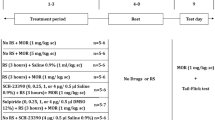Abstract
The ambulation-increasing effect of morphine (10 mg/kg SC) persisted for approximately 3 h with a peak effect at around 1 h after the administration. This was examined on four occasions at 3-day intervals. Thus, treatment regimen-induced sensitization and the 3-h overall activity in the fourth administration was about 1.7 times higher than that in the first administration. Post-morphine treatments with naloxone (1 mg/kg SC) at 0 (i.e., simultaneously with) to 30 min after each morphine administration almost completely inhibited the induction of morphine sensitization. However, post-morphine treatments with naloxone at 1 h and later had no such inhibitory effect. Similarly, physical restriction of the ambulation of mice for 3 h (restraint), by putting them in a jar (6 cm in diameter, and 15 cm in height) inhibited the induction of morphine sensitization when restrain was started 0–30 min after each administration of morphine. Restraint starting 1 h and later did not alter the morphine sensitization. Post-morphine treatment with saline at any times did not change morphine sensitization. Furthermore, repeated administration of saline alone, naloxone alone, and saline with naloxone post-treatment or restraint did not change the sensitivity to morphine. These results clearly indicate that free ambulation for at least 1 h after the administration of morphine, i.e., the latency to reach the peak effect, is required completely to induce sensitization to morphine in terms of ambulation in mice.
Similar content being viewed by others
References
Abercrombie EA, Keefe KA, Difrischia DS, Zigmond MJ (1989) Differential effect of stress on in vivo dopamine release in striatum, nucleus accumbens, and medial frontal cortex. J Neurochem 52:1655–1658
Buxbaum DM, Yarbough GG, Garter ME (1973) Biogenic amines and narcotic effects. I. Modifications of catecholamine levels. J Pharmacol Exp Ther 185:317–327
Deroche V, Piazza PV, Casolini P, Maccari S, Le Moal M, Simon H (1992) Stress-induced sensitization to amphetamine and morphine psychomotor effects depends on stress-induced corticosterone secretion. Brain Res 598:343–348
Deutsch AY, Tam SY, Roth RH (1985) The determinants of stress-induced activation of the prefrontal dopamine system. Prog Brain Res 85:367–403
Doherty MD, Gratton A (1992) High-speed chromoamperometric measurement of mesolimbic and nigrostriatal dopamine release associated with repeated daily stress. Brain Res 586:295–302
Iizuka M, Hirabayashi M (1983) Enhancing effect of morphine on ambulatory activity produced by repeated administration in mice. Nippon Yakurigaku Zasshi 82:293–301
Imperato A, Puglisi-Allegra S, Casolini P, Angelucci L (1991) Changes in brain dopamine and acetylcholine release during and following stress are independent of the pituitary-adrenocortical axis. Brain Res 538:111–117
Iwamoto ET (1981) Locomotor activity and antinociception after putative mu, kappa and sigma receptor agonists and antagonists. J Pharmacol Exp Ther 217:451–460
Kuribara H (1995a) Modification of morphine sensitization by opioid and dopamine receptor antagonists: evaluation by studying ambulation in mice. Eur J Pharmacol 275:251–258
Kuribara H (1995b) Inhibitory effect of restraint on induction of behavioral sensitization to methamphetamine and cocaine in mice. Pharmacol Biochem Behav (in press)
Kuribara H, Tadokoro S (1989) Reverse tolerance to ambulation-increasing effects of methamphetamine and morphine in 6 mouse strains. Jpn J Pharmacol 49:197–203
Kuschinsky K, Hornykiewicz O (1974) Effects of morphine on striatal dopamine metabolism: possible mechanism of its opposite effect on locomotor activity in rats and mice. Eur J Pharmacol 26:41–50
Reggiani A, Battaini F, Kobayashi H, Spano PF, Trabucci M (1980) Genotype-dependent sensitivity: role of different opiate receptor populations. Brain Res 189:289–294
Rethy CR, Smith CB, Villarreal JE (1971) Effect of narcotic analgesics upon the locomotor activity and brain catecholamine content of the mouse. J Pharmacol Exp Ther 176:472–479
Shaham Y, Kelsey JE, Stewart J (1995) Temporal factors in the effect of restraint stress on morphine-induced behavioral sensitization in the rat. Psychopharmacology 117:102–109
Swerdlow NR, Vaccarino FJ, Koob FG (1985) Effects of naloxone on heroin-, amphetamine- and caffeine-stimulated locomotor activity in the rat. Pharmacol Biochem Behav 23:499–501
Teitelbaum H, Giammatteo P, Mickley GA (1979) Differential effects of localized lesions of n. accumbens on morphine- and methamphetamine- induced locomotor hyperactivity in the C57BL/6J mouse. J Comp Physiol Psychol 93:745–751
Author information
Authors and Affiliations
Rights and permissions
About this article
Cite this article
Kuribara, H. Interval-dependent inhibition of morphine sensitization of ambulation in mice by post-morphine treatment with naloxone or restraint. Psychopharmacology 125, 129–134 (1996). https://doi.org/10.1007/BF02249411
Received:
Revised:
Issue Date:
DOI: https://doi.org/10.1007/BF02249411




